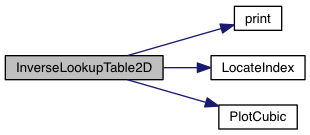|
PLUTO
|
|
PLUTO
|
Miscellaneous functions for handling 2D tables. More...
#include "pluto.h"
Go to the source code of this file.
Macros | |
| #define | LOG_INTERPOLATION NO |
Functions | |
| void | PlotCubic (double a, double b, double c, double d) |
| void | InitializeTable2D (Table2D *tab, double xmin, double xmax, int nx, double ymin, double ymax, int ny) |
| void | FinalizeTable2D (Table2D *tab) |
| int | LocateIndex (double *yarr, int beg, int end, double y) |
| int | InverseLookupTable2D (Table2D *tab, double y, double f, double *x) |
| int | Table2DInterpolate (Table2D *tab, double x, double y, double *f) |
| void | WriteBinaryTable2D (char *fname, Table2D *tab) |
Miscellaneous functions for handling 2D tables.
Definition in file math_table2D.c.
| #define LOG_INTERPOLATION NO |
Definition at line 194 of file math_table2D.c.
| void FinalizeTable2D | ( | Table2D * | tab | ) |
| void InitializeTable2D | ( | Table2D * | tab, |
| double | xmin, | ||
| double | xmax, | ||
| int | nx, | ||
| double | ymin, | ||
| double | ymax, | ||
| int | ny | ||
| ) |
Allocate memory for the arrays contained in the *tab structure and generate a uniformly spaced grid in log10(x), log10(y) within the range provided by xmin, xmax, ymin, ymax. On output, the function initializes the following structure members:
nx, ny lnxmin, lnxmax, lnymin, lnymax lnx[], lny[] dlnx, dlny dlnx_1, dlny_1 x[], y[] dx[], dy[] | [in,out] | tab | pointer to a Table2D structure |
| [in] | xmin | lower column limit. |
| [in] | xmax | upper column limit. |
| [in] | nx | number of equally-spaced column bins (in log space) |
| [in] | ymin | lower row limit. |
| [in] | ymax | upper row limit. |
| [in] | ny | number of equally-spaced row bins (in log space) |
Definition at line 15 of file math_table2D.c.

| int InverseLookupTable2D | ( | Table2D * | tab, |
| double | y, | ||
| double | f, | ||
| double * | x | ||
| ) |
Perform inverse lookup table interpolation: given a 2D table f(i,j)=f(x(i), y(j)) and the value of y, find the value of x. The algorithm proceeds by a combination of 1D lookup table algorithms:
j such that y[j]<y<y[j+1];j and j+1 where the value of y is given.ib and ie at j and j+1 using 1D lookup table.i and invert the bilinear interpolant by solving
![\[ f = f_{i,j}(1 - x_n)(1 - y_n) + f_{i+1,j}x_n(1 - y_n) + f_{i,j+1}(1 - x_n)y_n + f_{i+1,j+1}x_ny_n; \]](form_54.png)
 (normlized coordinate between 0 and 1).
(normlized coordinate between 0 and 1).and y.| [in] | tab | a pointer to a Table2D structure |
| [in] | y | the ordinata |
| [in] | f | the value of the function |
| [out] | *x | the value of the abscissa. |
y is below range;y is above range. Definition at line 196 of file math_table2D.c.


| int LocateIndex | ( | double * | yarr, |
| int | beg, | ||
| int | end, | ||
| double | y | ||
| ) |
Given an array yarr[beg..end] and a given value y, returns the array index i such that yarr[i] < y < yarr[i+1] (for increasing arrays) or yarr[i+1] < y < yarr[i] (for decreasing arrays). yarr must be monotonically increasing or monotonically decreasing.
| [in] | yarr | the 1D array |
| [in] | beg | initial index of the array |
| [in] | end | final index of the array |
| [in] | y | the value to be searched for |
Reference
Definition at line 144 of file math_table2D.c.

| void PlotCubic | ( | double | a, |
| double | b, | ||
| double | c, | ||
| double | d | ||
| ) |
| int Table2DInterpolate | ( | Table2D * | tab, |
| double | x, | ||
| double | y, | ||
| double * | f | ||
| ) |
Use bilinear interpolation to find the function f(x,y) from the 2D table *tab. Since the grid is equally spaced in log(x) and log(y), the (i,j) indices such that x[i] <= x < x[i+1] and y[j] <= y < y[j+1] are found by a simple division. Then bilinear interpolation can be done in either log or linear coordinates. The latter is expected to be slightly faster since it avoids one pow() operation.
| [in] | *tab | a pointer to a Table2D structure |
| [in] | x | the abscissa where interpolation is needed. |
| [in] | y | the ordinata where interpolation is needed. |
| [out] | *f | the interpolated value |
x is below column range;x is above column range;y is below row range;y is above row range. Definition at line 430 of file math_table2D.c.


| void WriteBinaryTable2D | ( | char * | fname, |
| Table2D * | tab | ||
| ) |
The binary table is a compact format used to write a 2D array together with simple structured coordinates. The file consists of the following information:
nx
ny
<x[0]..x[nx-1]>
<y[0]..y[ny-1]>
<q[0][0]..q[0][nx-1]
q[1][0]..q[1][nx-1]
.......
q[ny-1][0]..q[ny-1][nx-1]>
All fields are written in binary format using double precision arithmetic.
Definition at line 528 of file math_table2D.c.
